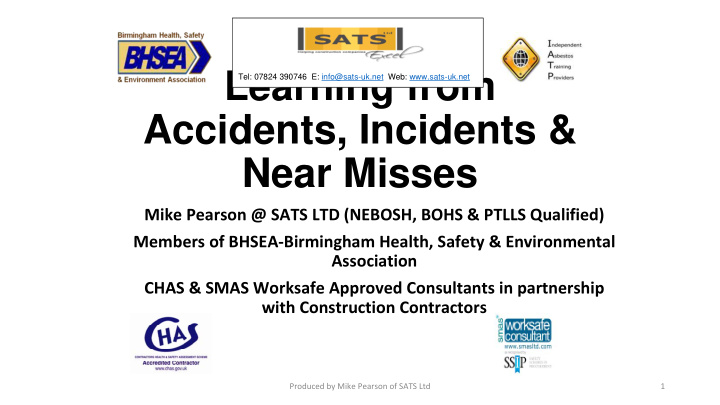



Learning from Tel: 07824 390746 E: info@sats-uk.net Web: www.sats-uk.net Accidents, Incidents & Near Misses Mike Pearson @ SATS LTD (NEBOSH, BOHS & PTLLS Qualified) Members of BHSEA ‐ Birmingham Health, Safety & Environmental Association CHAS & SMAS Worksafe Approved Consultants in partnership with Construction Contractors Produced by Mike Pearson of SATS Ltd 1
Learning from Accidents, Incidents & Near Misses The basics to maximise learning • Investigate as soon as possible ‐ whilst everything is fresh in the mind • Obtain photos & statements, speaking to the IP, witnesses & the person in charge, try to avoid formal interviews ‐ use informal questioning to get people’s recollection of what happened “in their own words” • Prepare your own notes before you chat to people ‐ it is easy to forget to ask something that may be difficult to ask again later. • Be open minded ‐ do not assume facts, gather them. • Stick to facts for legal matters, but go way beyond facts to learn more.
Our findings over the last 10 years- the results: • The reasons for an incident occurring can be categorised as: • Human error or human nature ‐ lack of care, attention, simply thinking it will be alright just this once or even stupidity! • Lack of familiarity or over ‐ familiarity with the work ‐ new or vastly experienced people • Process or procedural matters ‐ incorrect selection of equipment, correct work methods being ignored or workers unaware of them • Inadequate Management or supervision ‐ poor surveying, lack of planning, non ‐ checking of work in progress or simply a lack or presence in the workplace with over ‐ reliance on sub ‐ contractors • Communication issues ‐ assuming that people know what they are doing & will just get on with it correctly if they say that they know what they are doing without reference to RAMS!
Examples of two types accidents 1. A recurring one with 4 serious injuries to hands, arm & fingers involving chop saws.
The main issues found were: • Self ‐ employed workers sharing saws with faulty parts/ guards to save having to get their own out of the van, using them to cut long lengths of timber without sufficient support, their hands too close to the blade and having to apply excessive downward pressure to hold the material. • Workplace supervision did not carry out full inspections of sub ‐ contractors equipment, expecting that the tools were OK to use. • In two incidents workers were forced to wear gloves due to “Principal Contractors blanket rules”, whereas both HSE & CITB guidance stipulates that “gloves must not be worn when using machinery with serrated blades”. This was stated within the RAMS, but the contractors were made to amend the RAMS to state that gloves must be worn! • In one of the accidents the glove drew with arm into the saw & the IP had to endure bits of glove being taken out of his injured arm & hand with a pair of tweezers! • Resultant actions: Management must inspect all equipment, whoever owns it • Watch users in action to spot unsafe practices • Do not wear gloves with serrated cutters • Never cut unsupported items with items that are less then 500mm long to be clamped in position • Deliver tool box talks to remind everyone of the actions to take as often as necessary
2. Two falls from height of around 6 m resulting in minor injuries. The first one occurred around 15 mins after an inspection of the site including the scaffold by the site manager, an access ladder was clipped at top & bottom on the stiles using scaffold clips, the 4 th person climbing reached the top of the ladder by which time the top clip had worked loose & the ladder slipped sideways. • Resultant actions: NEVER use scaffold clips & always affix both sides of ladders at the top. • Use rope to lash ladders so that the responsibility doesn’t rest solely with scaffolders to tie ladders who are unlikely to be on ‐ site to check ladder ties. • Deliver tool box talks to remind everyone of the actions to take as often as necessary.
Second fall through a new roof in progress • The other fall involved a roofer who fell through a roof when he was loading out roof tiles on a new build project after it was felted & battened, a batten he trod on broke, his weight then went onto the next one which also gave way so he fell through the felt. The housebuilding sector uses fall mitigation equipment, but it tends to be removed after felt & battening to allow other work below to proceed. Battens are graded by manufacturers so deemed to be “fit for purpose” without fault. • Resultant actions: Housebuilders to be persuaded to retain fall mitigation measures until the roof has been tiled. • Roofers must thoroughly inspect all battens for weaknesses, rejecting any dubious ones, battens breaking during loading out to be reported as a “Near miss” to assess how often this occurs? • Deliver tool box talks to remind everyone of the actions to take as often as necessary.
Thanks for listening- hope this has provoked some thoughts to help you in both preventing & learning from accidents?
Recommend
More recommend